Alumnus part of Pulitzer Prize-winning team
David Carson, St. Louis Post-Dispatch - Aug. 9, 2014
Residents taunt police officers who were arriving to break up an angry crowd on Canfield Drive in Ferguson, hours after an officer killed Michael Brown. Rumors state that Michael Brown had his hands up when he was shot by officer Darren Wilson.(Photo caption provided by St. Louis Post-Dispatch)
The photography staff of the St. Louis Post-Dispatch, which includes RIT alumnus David Carson, won the Pulitzer Prize for Breaking News Photography on Monday.
The award was for the newspaper’s coverage of the events in Ferguson, Mo., following the police shooting of Michael Brown, an unarmed black teenager, by a white police officer.
“Your celebration is tempered by the fact that someone lost their life at the beginning of these events,” said Carson ’94 (professional photographic illustration), who has worked at the Post-Dispatch since 2000. “It’s really a nice honor. I’m proud of the work we did as a staff.”
Carson is one of eight RIT graduates who have won a combined 12 Pulitzer Prizes. He was part of the staff of eight photographers and three editors who submitted a gallery of 19 photos from the shooting scene, street protests, funeral and arson fires. Carson contributed seven of the 19 photos.
The Pulitzer Prize Board honored the photo staff “for powerful images of the despair and anger in Ferguson, Mo., stunning photojournalism that served the community while informing the country.”
Carson said he wasn’t working the day of the shooting or the first night of the riots but the self-described news junkie was watching the events unfold on Twitter. He asked the photographers on the scene if they needed help.
“I felt compelled to get out there and help tell this story,” he said.
William Snyder ’81, a professor and program chair of the university’s photojournalism program, said Carson made some of the most iconic images from the Ferguson protests under extremely difficult circumstances.
Carson consulted with Snyder, a winner of four Pulitzer Prizes, when working on the Pulitzer entry.
“He represents the very best traditions of our program: resourcefulness, professionalism under pressure and great storytelling images,” Snyder said. “I am so very proud of him and this accomplishment. Congratulations to him and the rest of the Post-Dispatch photo staff.”
Here is more on the other RIT graduates who have won Pulitzer Prizes:
Snyder, winner of Pulitzer Prizes in 1989, 1991, 1993 and 2006 while working for The Dallas Morning News. Snyder was honored in 1989 in the Explanatory Journalism category. Snyder was part of a three-person team that reported how the National Transportation Safety Board conducts air-crash investigations following a crash in 1986. In 1991, Snyder won a Pulitzer in the Feature Photography category for his images of ill and orphaned children living in deplorable conditions in Romania. Snyder and Ken Geiger ’11 won in the Spot News category in 1993 for their images of the 1992 Summer Olympics in Barcelona. Under Snyder’s leadership as director of photography at The Dallas Morning News, the staff earned a Pulitzer in 2006 in the Breaking News Photography category for its coverage of Hurricane Katrina.
Robert Bukaty ’82 and Dan Loh ’95, winners of Pulitzer Prize in 1999 while working for The Associated Press. Bukaty and Loh were part of the AP photography staff honored in the Feature Photography category for their series of images of the key players and events surrounding President Bill Clinton’s affair with Monica Lewinsky and the impeachment hearings.
Paul Benoit ’76, winner of the Pulitzer Prize in 1979 in the Feature Photography category while working for Boston Herald-American. Benoit and members of the paper’s photography staff won for their coverage of the blizzard of 1978.
Stan Grossfeld ’73, winner of two Pulitzer Prizes in 1984 and 1985 while working for The Boston Globe. Grossfeld won in 1984 in the Spot News category for his series of photographs revealing the effects of war on the people of Lebanon. In 1985, he earned a Pulitzer in the Feature Photography category for a portfolio of images of the famine in Ethiopia and of illegal aliens on the Mexican border. Grossfeld was also among the finalists for Pulitzers in 1984, 1994 and 1996.
Anthony Suau ’78, winner of Pulitzer Prize in 1984 for Feature Photography while at The Denver Post, for a portfolio of images depicting the tragic effects of starvation in Ethiopia and for a single photograph of a woman at her husband’s gravesite on Memorial Day.
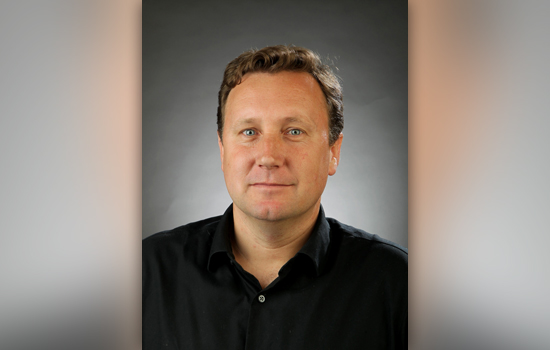 David Carson
David Carson
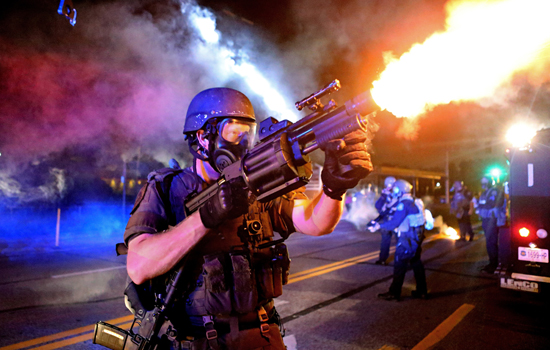 A member of the St. Louis County Police tactical team fires tear gas into a crowd of people in response to a series of gunshots fired at police during demonstrations in Ferguson. For more than two weeks, police and protesters clashed nightly. (Photo caption provided by St. Louis Post-Dispatch)
David Carson, St. Louis Post-Dispatch - Aug. 18, 2014
A member of the St. Louis County Police tactical team fires tear gas into a crowd of people in response to a series of gunshots fired at police during demonstrations in Ferguson. For more than two weeks, police and protesters clashed nightly. (Photo caption provided by St. Louis Post-Dispatch)
David Carson, St. Louis Post-Dispatch - Aug. 18, 2014
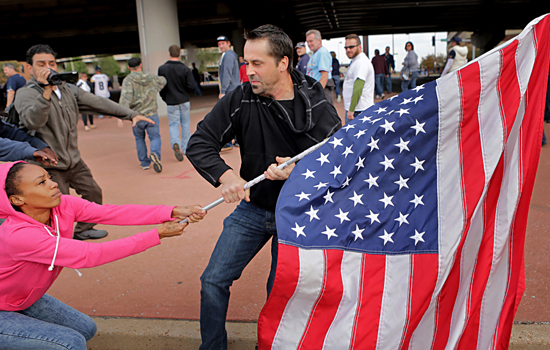 Ferguson protester Cheyenne Green struggles to hold onto an American flag as a football fan makes a grab for it outside the Edward Jones Dome after a St. Louis Rams game. (Photo caption provided by St. Louis Post-Dispatch)
David Carson, St. Louis Post-Dispatch - Oct. 19, 2014
Ferguson protester Cheyenne Green struggles to hold onto an American flag as a football fan makes a grab for it outside the Edward Jones Dome after a St. Louis Rams game. (Photo caption provided by St. Louis Post-Dispatch)
David Carson, St. Louis Post-Dispatch - Oct. 19, 2014
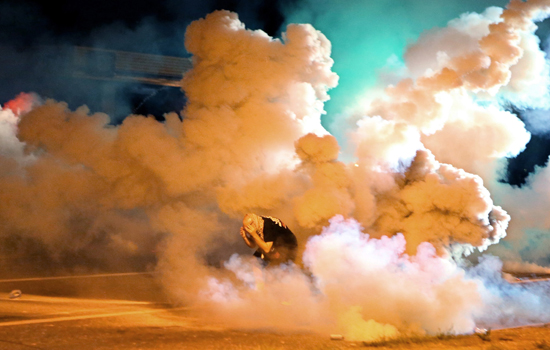 A protester shields himself from exploding tear gas canisters. On this night protesters attempted to throw Molotov cocktails, rocks and bottles at police. It was the fourth consecutive night police used tear gas to disperse the crowd. (Photo caption provided by St. Louis Post-Dispatch)
David Carson, St. Louis Post-Dispatch - Aug. 13, 2014
A protester shields himself from exploding tear gas canisters. On this night protesters attempted to throw Molotov cocktails, rocks and bottles at police. It was the fourth consecutive night police used tear gas to disperse the crowd. (Photo caption provided by St. Louis Post-Dispatch)
David Carson, St. Louis Post-Dispatch - Aug. 13, 2014
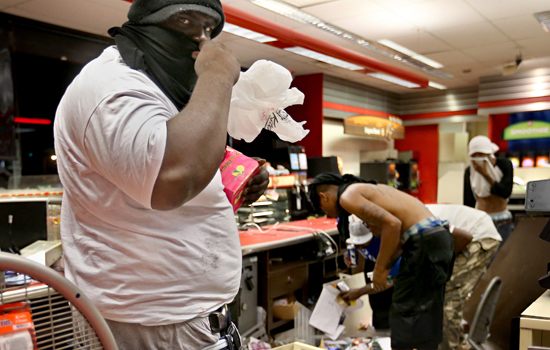 A looter armed with a gun in his waistband steals items from a QuikTrip after riots broke out at the end of a candlelight vigil for Michael Brown. The store was later set afire. (Photo caption provided by St. Louis Post-Dispatch)
David Carson, St. Louis Post-Dispatch - Aug. 10, 2014
A looter armed with a gun in his waistband steals items from a QuikTrip after riots broke out at the end of a candlelight vigil for Michael Brown. The store was later set afire. (Photo caption provided by St. Louis Post-Dispatch)
David Carson, St. Louis Post-Dispatch - Aug. 10, 2014














